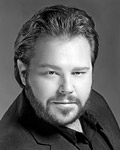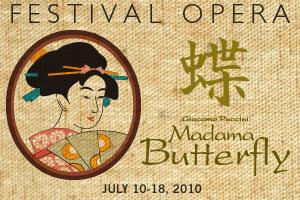Why is this Madama Butterfly different from all other Butterflys? It’s a question we often ask ourselves when pondering whether to spend another three hours at the opera seeing our second or fifth or 50th performance of Puccini’s final revision to his 1904 masterpiece.
Brian Staufenbiel, director of Festival Opera’s forthcoming Madama Butterfly, scheduled for three evening performances and one matinee in Walnut Creek’s Lesher Center for the Arts, has some answers.
“I’m hoping to bring out my love for the opera in the way I have set it, and the way our Butterfly goes through her journey,” he explained by phone. “Given the mandate that I create ‘something different and special’ for Butterfly lovers, I have chosen fabrics, colors, and settings that bring out a kind of traveling puppet-show aesthetic. While there won’t be puppets acting out the parts onstage, we’ll use shadow puppets in the ‘prequels’ to each of the three acts to show what has led up to the action we’re about to experience.”

One thing is certain: When we who love opera see Butterfly, we aren’t afraid to cry our hearts out. Indeed, we seem to need a good cry, because we keep coming back for more. Puccini’s music for Luigi Illica and Giuseppe Giacosa’s story of a 15-year-old geisha (Cio-Cio San, aka Madama Butterfly) who falls hopelessly in love with and marries an American sea captain (Pinkerton), has his baby while he is at sea, and kills herself when her handsome prince returns three years later with his American wife in tow, renders Cio-Cio San’s plight so palpable that we suffer at her side.
Staufenbiel, whose last Bay Area effort was directing Ensemble Parallèle’s estimable Wozzeck, hopes to capitalize on the relatively intimate size of the Lesher Center’s Hofmann Theatre with a stage perspective that makes the singers seem closer than usual.

“You will feel like you’re watching a more focused, chamber opera–like performance,” he says. “I love Butterfly because it explores the power structure of cultures when they clash. The characters are very different, because they represent certain sociological aspects of the relationship between the U.S. and Japan at the time the opera takes place.
“We live in a golden age of opera performance, when most opera singers are also great actors. If I have my way, the characters will be very complex, and the production will do anything but spoon-feed one set take on the opera.”
Staufenbiel rejects interpretations of Cio-Cio San as a weak little woman who is taken advantage of. “Cio-Cio San is such a powerful woman,” he declares. “She has a such a strong will that she gives up everything, including her ties with her family and religion, for something and someone she really wants. All this happens while we listen to some of the greatest music ever written.”
If Staufenbiel has his way, this will be a Madama Butterfly to remember.

